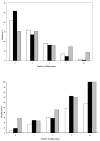Characteristics and outcomes of cancer patients in European ICUs
- PMID: 19200368
- PMCID: PMC2688132
- DOI: 10.1186/cc7713
Characteristics and outcomes of cancer patients in European ICUs
Abstract
Introduction: Increasing numbers of cancer patients are being admitted to the intensive care unit (ICU), either for cancer-related complications or treatment-associated side effects, yet there are relatively few data concerning the epidemiology and prognosis of cancer patients admitted to general ICUs. The aim of this study was to assess the characteristics of critically ill cancer patients, and to evaluate their prognosis.
Methods: This was a substudy of the Sepsis Occurrence in Acutely Ill Patients (SOAP) study, a cohort, multicentre, observational study that included data from all adult patients admitted to one of 198 participating ICUs from 24 European countries during the study period. Patients were followed up until death, hospital discharge or for 60 days.
Results: Of the 3147 patients enrolled in the SOAP study, 473 (15%) had a malignancy, 404 (85%) had solid tumours and 69 (15%) had haematological cancer. Patients with solid cancers had the same severity of illness as the non-cancer population, but were older, more likely to be a surgical admission and had a higher frequency of sepsis. Patients with haematological cancer were more severely ill and more commonly had sepsis, acute lung injury/acute respiratory distress syndrome, and renal failure than patients with other malignancies; these patients also had the highest hospital mortality rate (58%). The outcome of all cancer patients was comparable with that in the non-cancer population, with a 27% hospital mortality rate. However, in the subset of patients with more than three failing organs, more than 75% of patients with cancer died compared with about 50% of patients without cancer (p = 0.01).
Conclusions: In this large European study, patients with cancer were more often admitted to the ICU for sepsis and respiratory complications than other ICU patients. Overall, the outcome of patients with solid cancer was similar to that of ICU patients without cancer, whereas patients with haematological cancer had a worse outcome.
Figures



Comment in
-
Patients with cancer on the ICU: the times they are changing.Crit Care. 2009;13(2):122. doi: 10.1186/cc7721. Epub 2009 Mar 2. Crit Care. 2009. PMID: 19291271 Free PMC article.
References
-
- Staudinger T, Stoiser B, Mullner M, Locker GJ, Laczika K, Knapp S, Burgmann H, Wilfing A, Kofler J, Thalhammer F, Frass M. Outcome and prognostic factors in critically ill cancer patients admitted to the intensive care unit. Crit Care Med. 2000;28:1322–1328. doi: 10.1097/00003246-200005000-00011. - DOI - PubMed
-
- Groeger JS, White P, Jr, Nierman DM, Glassman J, Shi W, Horak D, Price K. Outcome for cancer patients requiring mechanical ventilation. J Clin Oncol. 1999;17:991–997. - PubMed
Publication types
MeSH terms
LinkOut - more resources
Full Text Sources
Medical

